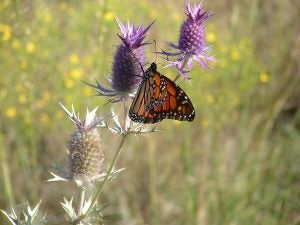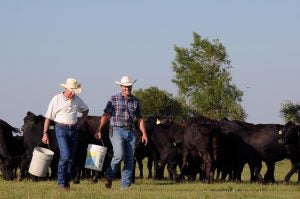
A monarch butterfly nectars on an eryngo plant at Wagley Ranch on October 11. Read more about the monarch and explore David’s notes from the field here.
I recently returned to Wagley Ranch near Mineral Wells, Texas to work with some of the very first landowners participating in the emerging Monarch Butterfly Habitat Exchange.
The visit was the last on my fall field testing tour of the state, during which I visited five Texas ranchers in just six weeks. It was great to end on a high note at Wagley Ranch, where we had the chance to see southward migrating monarchs. We even saw one monarch feeding on an eryngo plant.
It was a wonderful reminder of why our work with these ranchers is so important, because the habitat they are restoring and enhancing is providing a new home to monarchs. Each acre of healthy habitat restored will support 70 butterflies on their migration to their wintering grounds in Mexico.
So how do we bring these activities to scale in time to save the monarch from extinction? With the right tools, the right practices, and the right people.
[Tweet “Why there’s more hope than ever for the monarch’s recovery, via @GrowingReturnshttps://edf.org/X32”]
The right tools
I visited Wagley Ranch back in the spring to apply the Habitat Quantification Tool (HQT) – a science tool we recently developed with partners to assess the quality of monarch habitat – to the restoration area that the landowners identified. I applied the HQT again on my visit this fall. It’s important that we apply the HQT during both the spring and fall seasons to determine habitat conditions for both the northward and southward migrations, and to give us a full baseline assessment for the project.

Monarchs rely on milkweed for breeding in the spring, and wildflowers for nectaring in the fall. (Photo credit)
Monarchs have different habitat needs at different times during their migration – spring is more important for breeding and fall more important for nectaring – so we have to consider this in restoration planning. Once we have the baseline calculations, we can see where there is the most potential for improvement.
For example at Rust Ranch, another pilot project in Bastrop County, the spring HQT score was 32% (the score is a percent of 100, which is perfect monarch habitat). The lack of milkweed available at this particular site drove the spring score down, since milkweed is so essential for breeding in the spring.
With this knowledge, we are working with the landowners at Rust Ranch to focus on restoration activities that will improve milkweed habitat. These activities include a combination of mowing to reduce competition from grasses and planting milkweed.
The right practices
The Monarch Butterfly Habitat Exchange offers a menu of restoration activities that landowners can choose from. The HQT simply helps landowners make the best choice for their property by showing them the value that each restoration activity or practice will have for monarchs, which ultimately translates into dollars. We want to help landowners choose the practices that have the most bang for the buck.

In this video, meet George and Amy Greer of the Winters-Wall Ranch. See why they are so excited to participate in the Monarch Butterfly Habitat Exchange. Click to watch >>
Restoration practices include but are not limited to: mowing, planting, prescribed burning and prairie restoration.
Elm Ridge Ranch is another pilot project that will be pursuing mowing as part of their restoration plan. Mowing helps to reduce competition for milkweed from other plants and improves habitat quality by reducing and controlling invasive species.
Another common restoration activity that landowners selected was combining prescribed burning with adjusted cattle grazing. These management plans were assigned to Shield Ranch and Winters-Wall Ranch, where the focus was increasing the abundance of wildflowers for monarchs to feed on during both the spring and fall migration seasons.
The right people

Private lands make up the vast majority of the monarch butterfly’s range, and agricultural lands are the best opportunity to put large, multi-hundred and multi-thousand-acre restoration projects in place at great scale and with great efficiency. (Photo Credit: U.S. Department of Agriculture)
Even more important than the science tools and the restoration practices are the people who are willing and eager to manage their land to make it a better home for monarchs. From ranchers in Texas to farmers in the Midwest, we’ll be working to identify these natural stewards who are in the best position to help monarchs.
In addition to farmers and ranchers, there is a huge opportunity for concerned citizens, business leaders and philanthropic foundations to play a significant role in the monarch’s recovery. We will be looking to them to invest in the exchange and fund the next generation of restoration projects.
I am hopeful that with all the enthusiasm I have seen in the field, in meetings, in the media and beyond, that we can do this, together.
Related:
How the Midwest can save the monarch >>
Once a pesky plant for farmers, this weed presents a new opportunity >>
From testing to launch: A new program for monarchs takes flight >>










3 Comments
We raised and released over 30 monarchs this year…a drop in the hat, but at least it is something.
I have a butterfly garden. The most important thing is that all this has been shared with grade school students, even the tagging of the last butterflies on their way to Mexico.
We have raised the caterpillars through release for years and had a bumper crop this year.
I want to support Monarchs where I live in Middle Tennessee. Can anyone please direct me to guides and resources?